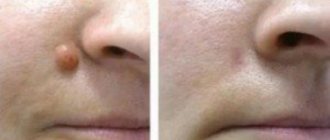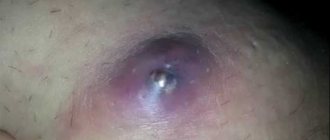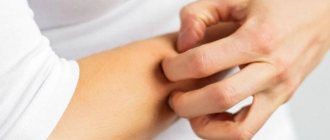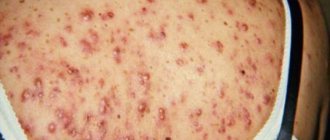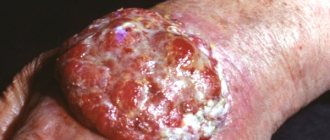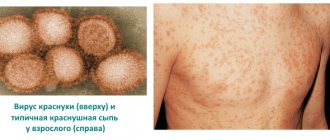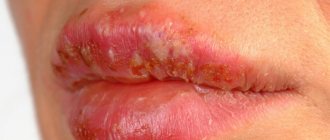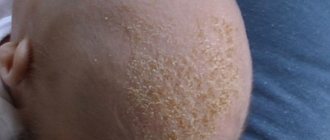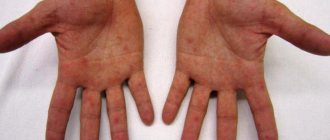Causes of the rash
The condition of the skin indicates the quality of work of internal organs and systems. There are many reasons for the appearance of signs of disease on the skin.
The rash appears when:
- changes in the functioning of the immune system;
- allergic reactions caused by long-term use of medications;
- pathological diseases of the digestive and endocrine systems;
- liver dysfunction and connective tissue disease;
- benign and malignant neoplasms.
In addition, the occurrence of acne is catalyzed by stress and nervous disorders.
Diagnosis is based on familiarization with the anamnesis and an objective study of the state of the body, including:
- determining the location and order of appearance of rashes;
- studying the duration of the development process and the nature of the rash;
- familiarization with predisposition to allergic reactions;
- identification of medications that were taken during the previous period.
It is imperative to check whether a person has pathological diseases and the possibility of contact with infectious patients. Treatment is prescribed after examining the patient and determining the source of the rash.
Diseases
The most common cause of skin rashes is illness.
The etiology of their development may be different, but they have characteristic accompanying symptoms:
- a sharp increase in body temperature;
- chills, malaise, dizziness;
- loss of appetite, nausea;
- disruption of the gastrointestinal tract, diarrhea;
- runny nose, cough, headache.
Pain when swallowing, pain in the eyes, and tinnitus are also possible. Infectious diseases are transmitted by airborne droplets. The rash appears in the initial stage of the disease and spreads virtually throughout the body.
Non-infectious skin lesions occur with allergies and diseases of connective tissue or blood vessels, such as systemic lupus erythematosus, thrombocytopenic purpura, lichen and others.
Sun rash
A certain type of allergic reaction that occurs in people who are sensitive to ultraviolet light.
- In 60% of cases it appears on the face, and in the rest on open areas of the body.
- It manifests itself as redness with itching; with prolonged exposure to the irritant, blisters may appear or peeling may begin.
- After the rash disappears in the places where it is localized, the skin remains pigmented.
The disease can be genetic or appear as a result of long-term use of certain medications.
Rashes after childbirth
They develop as a result of decreased immunity and weakening of the body caused by pregnancy and childbirth.
The reason may be:
- chronic diseases;
- disorders of the gallbladder and liver;
- psychological stress;
- lack of calcium and weakened immunity of women.
An increase in cortisol synthesis with a simultaneous increase in progesterone upsets the balance, leading to hormonal changes. The use of creams, ointments, medications and poor diet can cause an itchy rash similar to hives.
Contact dermatitis
Contact dermatitis is an allergic skin reaction.
Symptoms
The skin darkens or turns red and may become itchy or dry. Contact dermatitis can also cause skin swelling or blistering. The size of the rash depends on how much skin came into contact with the allergen.
The rash may be round if the object causing the reaction is round. For example, if a person is allergic to nickel, wearing a nickel watch may cause a circular rash to form on the wrist.
Treatment
The most effective way to combat contact dermatitis is to identify and prevent contact with the allergen or irritant. Ointments can reduce swelling and irritation.
What does the appearance of the rash indicate?
Any type of rash is a primary element, as it appears on clean skin. Depending on the intensity and location, it indicates disturbances in the functioning of the entire organism or its individual systems.
It is impossible to make a diagnosis based solely on the fact that the rash on an adult’s body itches, as additional research is required.
Skin neoplasms occur in several types:
- bubbles with liquid,
- scaly formations;
- with hyperemia of the affected area;
- rising on the skin;
- chaotically located, similar in color to the dermis.
In fact, with all rashes there is itching, burning, dryness and flaking of the skin.
Minor rash
May appear during the latent phase of the disease.
On the skin, this type of rash is represented by papules, blisters or spots:
- have a shade from pale pink to bright red;
- slightly convex to the touch;
- the skin where they are located is rough.
The place of localization, as well as the dynamics of spread, is determined by the type of disease and its duration.
Large rash
The rashes are shaped like mosquito bites. May appear as pimples, dots or spots. Large spots cover certain parts of the body with vitiligo, typhoid, syphilitic roseola, toxicoderma. The spot partially disappears on palpation and then appears again.
Red rash
It mainly appears in people with hypersensitivity to food and medications. It is a clearly defined area of bright red skin. With erysipelas and infectious diseases, the localization of the rash is slightly elevated.
Watery rash
Blisters, consisting of bubbles, mostly round in shape, filled with cloudy, clear or bloody liquid, are a skin lesion of an infectious or allergic nature.
- Rashes with a diameter not exceeding ½ cm, located in the epidermis or under it, appear with herpes, eczema, allergic dermatitis, chickenpox, and herpes zoster.
- Larger manifestations are located on inflamed and unchanged skin and appear due to the detachment of the epidermis from the dermis. The cause is insect bites, plant burns, urticaria, toxic-allergic dermatitis, as well as hereditary genetic diseases.
If this type of rash does not go away within 24 hours and tends to increase in localization, then the help of a specialist is needed.
Ringworm
Despite its name, ringworm is a fungal infection of the skin—it is not caused by any parasite. The infection gets its name because it causes a rash that is usually round, with a thin, raised ring around the edge.
Symptoms
The circular rash may initially be several centimeters across and may enlarge without treatment, or may appear as a round, flat spot, and the middle of the rash tends to heal first.
On lighter skin, the ringworm rash is red or pink, while on darker skin it is silver or brown. The skin around the rash may be dry or scaly, and the rash may be extremely itchy.
Ringworm can appear on any part of the body, and the rash may not be ring-shaped if it appears on the scalp, soles of the feet, palms, groin, or nails. Athlete's foot is a type of ringworm.
Ringworm is contagious and can be spread from one person to another through close contact.
Treatment
Treatment includes an antifungal cream or gel. A man must:
- take medications for 2-4 weeks, even after symptoms disappear
- keep skin clean and dry
- Wash your hands after touching the rash to prevent it from spreading to other parts of the body.
The risk of developing ringworm is higher in warm, humid weather.
To reduce the risk:
- Always shower after training
- Change clothes daily
- Don't share towels
- Take a pet who has hairless patches or other symptoms of ringworm to a veterinarian.
Diseases that cause rash
In most cases, the appearance of a rash on the body of an adult, especially if it itches, is evidence of the onset of diseases.
- In some types of infection, skin lesions persist until complete recovery, while in others they may disappear after the disease moves to a new phase of development.
- All rashes have specific signs that indicate the type of pathology.
Children's diseases in adults often give a picture different from the classical form.
Hives
Appears on different parts of the body in the form of small rashes, which can gradually merge into a single whole.
The reason may be:
- high sensitivity to a certain type of pathogen, such as food, chemicals, animal hair, insect bites and others;
- disruption of the mechanism for the production of antigens and antibodies as a result of long-term use of medications, or a malfunction of the immune system;
- release of enzymes and proteins from leukocytes.
The shape, total area and rate of formation depend on the source of the irritation that became the catalyst.
Scabies
This rash on the body of an adult is very itchy, especially in the evening and at night. The cause is the scabies mite, which makes its moves in the upper layer of the epidermis.
The incubation period averages 1.5-2 weeks.
- If a person is infected not for the first time, then an allergic reaction may begin 2 days after ticks come into contact with the skin.
- It manifests itself in the formation of vesicles and papules at the sites of parasite penetration.
The passages look like convex whitish lines located in places characteristic of the development of itching.
Stevens-Johnson syndrome
The disease is toxic-allergic in nature.
It is considered a malignant type of exudative erythema.
- The process involves the mucous membranes of the eyes and mouth, as well as the organs of the genitourinary system.
- The cause is an allergic reaction to taking antibacterial drugs.
- Due to the suppression of the body's defense reactions, damage occurs to the skin and small blood vessels adjacent to it.
- One of the symptoms of development is a numerous rash of purplish-red spots with blisters rising above them, which contain blood or watery fluid.
The exact mechanism causing the disease has not been established. Some experts believe that the hereditary factor plays a big role here. According to statistics, 1/10 patients die.
Fungal infections
It appears as a small rash, more like a speck or an insect bite.
- The fungus requires certain conditions to grow, so the main sites of infection are wet areas of the body: toes, armpits and groin, abdominal area under the fat fold, mammary glands, scalp and face.
- The disease is transmitted by contact.
- You can become infected in the shower, swimming pool and other common areas.
- The rashes are constantly weeping and itchy. White or red swelling and diaper rash form around them.
- There is a tendency for several sites of manifestation to merge into one.
The color, type and nature of the rash varies depending on the type of pathogen.
Intestinal infections
The appearance of rashes during intestinal infections is secondary, since the main symptoms are diarrhea, vomiting, fever, weakness, chills and enlarged lymph nodes. The skin rash is typical for typhoid and typhus, paratyphoid A and B, intestinal yersiniosis, helminthic infestations, cholera, dysentery and a number of other diseases.
Contact dermatitis
Damage occurs through direct contact of an area of the skin with an irritant.
- A very itchy rash appears in localized areas.
- The rash areas are susceptible to infection and require special care.
- To get rid of the disease, it is necessary to accurately identify the cause and eliminate it.
Pyoderma
Infection with staphylococcus and streptococcus causes the formation of a rash with pus on the skin. They get deep into the skin through wounds and begin to develop due to disruptions in metabolic processes, disruptions in the gastrointestinal tract, circulatory and central nervous systems. The catalyst for the disease can be therapeutic methods of treatment with long-term use of drugs of certain groups.
Mainly sweat and greasy hair is affected, hair follicles are affected:
- the inflammatory process affects the superficial and deep levels;
- a rash appears on the skin at the site of the disease, consisting of small bubbles filled with a cloudy liquid;
- After healing, the crust disappears without leaving scars.
Without a special course of antibiotics and treatment of skin lesions, it is impossible to stop the disease.
Furunculosis
The inflammatory process around the hair follicle caused by a staphylococcal infection can cause its purulent-necrotic disease.
- Hypovitaminosis, diabetes and chronic intoxication can provoke the formation of multiple rashes.
- At the initial stage, only the follicle is affected, and subsequently it spreads to the adjacent sebaceous gland.
- After opening, thick pus is released and in the resulting ulcer you can see the rod, which is subsequently rejected with purulent masses and blood.
The disease can be localized in one area and be widespread. Treatment is carried out under the supervision of specialists. The main cause of rashes is poor hygiene.
Folliculitis
A disease caused by inflammation of the hair follicles as a result of viruses, fungi, bacteria and parasites entering the skin. Most often, pathogens enter small wounds and microcracks on the skin.
The initial stage is characterized by the appearance of small red rashes around the hairs, which then turn into pustules:
- after opening, a crust forms on the skin;
- complications cause the formation of boils and abscesses.
Development occurs when metabolic processes are disrupted, as well as non-compliance with personal hygiene rules.
Eczema
A disease in which inflammation of the skin occurs, most often accompanied by severe itching. The first symptom is the appearance of pink blisters and rashes in the upper subcutaneous layer. In the affected areas the cover is thickened, dry, reddened and flaky.
When scratched, the skin rash becomes wet and bleeds. The catalyst can be constant exposure to a certain stimulus. The appearance of the disease in 60% of cases is explained by heredity and genetic predisposition. Seborrheic eczema in adults is rare. It can be triggered by stress and hormonal imbalances.
It is characterized by:
- the presence of scabs on the eyelids and in the external auditory canal;
- on the face it appears in the locations of the sebaceous glands;
- It doesn't itch and is easy to treat.
Due to the large number of types, treatment of the disease is carried out on an individual basis.
Psoriasis
The rash on the body of an adult is localized mainly on the elbows, knees and head, and does not itch too much. When neglected, it can spread to the ears, chest and other parts of the body.
- In 90% of cases, the disease is hereditary. May occur due to infection.
- At the initial stage, small, pink-red dry plaques of round or oval shape appear.
- A silvery, constantly crumbling coating is typical for this type of rash.
It is known that the cause is the accelerated growth of skin cells, but this issue has not been thoroughly studied. Visually, the manifestations are similar to eczema, as a result of which psoriasis is often mistaken for it.
Lichen
This disease can be a consequence of infectious infection and occur as a concomitant with lymphomas, leukemia and other disorders of the hematopoietic system. Caused by a member of the herpesvirus group. The most common types are: multi-colored, pink and ringworm species.
Basically, skin rashes are located segmentally and have one-sided localization:
- the location is not limited to a certain area of the body;
- presented as a rash in the form of bubbles with a slight depression at the top;
- neoplasms appear gradually, one group after another;
- in the affected areas, the skin has redness with a brownish tint.
Ringworm is typically characterized by hair loss in the areas where it forms and the formation of suppuration. After the end of the development process, scars remain at the site of the rash, as well as areas of depigmented skin.
Allergy
It mainly appears as a response to food or drug intolerance, and can also occur after the administration of serum in the treatment of the underlying disease.
Localizations on the chest and limbs indicate an allergic nature:
- appear unexpectedly and quickly;
- can change shape and location;
- They always itch a lot.
If the cause is contact with an irritant, then the rash on the body of an adult in places that came into contact with the allergen is very itchy. These rashes do not have a characteristic appearance; they can be either macular or maculopapular, and tend to merge. With further exposure to the allergen, the amount of rash increases.
In areas where the rash persists for a long time, papules and blisters appear, and the superficial layers of the skin may begin to peel off.
Syphilitic rash
Appears in the second period of development. It does not cause any discomfort and is detected only by visual inspection. A small rash appears on the abdomen. May be expressed as papules, nodules or spots. During this period, the patient is already a carrier and serves as a source of infection. The duration of the rashes is from 1 to 1.5 months, after which they disappear without a trace.
When reappearing:
- localized in the groin, on the shoulders and chest, near the anus;
- the rashes are sporadic and pale in color.
Left untreated, the disease causes irreversible damage to internal organs and the brain.
Diagnostics
A dermatologist will consider associated symptoms and any exposure to allergens and irritants when diagnosing a ring rash.
An allergist can check for skin reaction triggers, which are often pet dander or medications. Skin, blood, or urine testing may be ordered, but patch tests are usually performed. This involves placing strips on the back containing small amounts of allergens. The doctor then removes the strips after 48 hours to check for an allergic reaction.
Keeping track of foods, drinks, medications, exercise, and symptoms in a diary can help a person determine what may trigger a reaction.
Localization of the rash
Depending on the location of the rash, the nature of its spread and its shape, the rash can indicate both an allergic reaction and be a signal of skin diseases.
On the face
This area is difficult to hide, so it is the rash that causes the most trouble for the patient.
The reasons are:
- corticosteroid drugs used in therapy;
- cosmetics and ointments containing allergens;
- poor personal hygiene;
- disruption of the endocrine system;
- age-related hormonal changes;
- concomitant and chronic diseases.
In addition, prolonged exposure to direct sunlight and frequent visits to spas can cause a weakening of the skin's protective reactions and lead to the appearance of a rash.
On the body
A rash on the body is an indicator of the development of infectious diseases:
- small red spots scattered throughout the body and without precise localization occur with syphilis, pityriasis rosea and drug toxicoderma;
- psoriasis, dermatitis, allergies and most childhood infectious diseases are characterized by a red rash in the form of papules, which form small tumors that gradually spread throughout the torso.
Only a dermatologist can make a diagnosis after examining the test results.
On the legs and arms
Dermatitis, fungal infections, poor personal hygiene, autoimmune and other diseases can lead to skin lesions on the hands and feet and the appearance of various rashes on them.
It is impossible to ignore a rash on these parts of the body, as they can signal a weakening of the body’s defense reactions, as well as be a consequence of an allergy to the use of a new product or the use of an inappropriate composition.
Rash all over the body
The appearance of redness, papules, plaques and rashes on all parts of the body most often occurs with diseases characteristic of childhood, such as measles, chickenpox, rubella.
Despite the fact that in adults these diseases are more severe than in children, nevertheless, if they consult a doctor correctly and in a timely manner, they do not pose a danger.
Much more dangerous are infections and associated pathologies, accompanied by a rash all over the body:
- scarlet fever;
- types of typhus;
- enterovirus and meningococcal infections.
Pseudotuberculosis, tuberculosis and other diseases are characterized by multiple manifestations of the rash.
Pediculosis
Many people had to deal with lice in childhood. However, adults may also develop a small rash due to the presence of the parasite on the scalp. Head lice is a disease that is easily transmitted through household contact. However, the presence of a sick person in the family does not mean that everyone will have to fight the pathology. Factors such as sleeping together, wearing the same headdress, using the same comb, etc. contribute to the development of the disease. Simple hygiene rules will help maintain a healthy scalp.
Once on the hair, lice spread quite quickly. One female lays hundreds of eggs during her life. Young lice appear in 6-7 days, and after a few weeks they can reproduce on their own. Parasites use human blood to reproduce. Therefore, the main symptom of lice is itching of the scalp. Parasite bites are quite painful. If the patient does not follow the rules of hygiene, purulent rashes may appear at the site of the bite due to the addition of a bacterial infection.
Pediculosis can be diagnosed in both children and adults
Long gone are the days when lice were treated with kerosene. Pharmacies have special preparations for external use that allow you to cope with parasites in a few days. But refusal of quality treatment will lead to serious complications. Neglected pediculosis can provoke the development of chronic dermatitis. In this case, longer and more expensive therapy will be required.
What does it mean if the rash itches?
Not all rashes are accompanied by itching. It is a symptom of a certain number of diseases.
- The rash itches when reacting to foods, medications, chemicals and other substances that are allergens to humans.
- The bites of mosquitoes, bees and other insects, including those parasitic on the human body, itch.
- The cause can also be nerve disorder, dermatitis and a number of infectious pathologies.
In any case, if a rash appears, you should consult a dermatologist, this is especially important if:
- lasts for several days and the amount does not decrease;
- a similar phenomenon occurs in someone close to you;
- in addition to rashes, there are other symptoms of diseases;
- the rashes begin to turn into blisters.
To reduce itching, you can take sedatives and antiallergic medications.
Hives
Hives are a reaction to temperature, food, medications, viral infections and other triggers.
Symptoms
Urticaria is characterized by the rapid appearance of intensely itchy, flat, raised, pale pink blisters, similar in appearance to nettle sting blisters. Hives can develop on any part of the body and can come and go quickly. In some people, the rash may be round and resemble insect bites.
Treatment
Antihistamines can reduce swelling and prevent hives if they occur as a result of exposure to an allergen. If hot weather causes hives, wear loose clothing and use sunscreen.
Treatment methods
The main thing when choosing methods of treatment is the correct diagnosis of the causes of the disease.
- Methods depend on the form and extent of the disease and may require surgical intervention.
- Initially, conservative treatment is used with the use of physiotherapy, the use of anti-inflammatory and antibacterial ointments, antifungal drugs, as well as external treatment of rashes.
- The treatment regimen is selected individually depending on the form and cause of the lesion.
- Non-infectious and non-allergic rashes can be treated with traditional medicine.
Any skin lesions should be treated under medical supervision. The dosage of medications taken is also agreed with a specialist.
Popular drugs for treating rashes
To relieve side effects and negative reactions of the body that occur with skin rashes, antihistamines are used.
The most common are tablets such as:
- Claritin;
- Allegra;
- Zyrtec;
- Semprex.
Doctors consider Suprastin and Tavegil to be a universal remedy, as they quickly relieve symptoms. The negative side is the feeling of drowsiness that occurs in patients due to depression of the central nervous system by the drug. Corticosteroids are used when there is no progress in treatment.
These are hormonal drugs and therefore require precise dosage:
- Metipred;
- Hydrocortisone;
- Dexamethasone;
- Diprospan.
Additionally, external medications are used. The greatest effect is achieved when using Levomikol, Lokoid, Gistan and other ointments.
All drugs have a number of contraindications, so self-medication with them is not recommended.
Folk remedies
The combination of traditional and folk medicine allows you to accelerate the achievement of a positive effect.
It is especially recommended to use herbal medicine if a rash appears on the body of an adult and bothers him and itches:
- Compresses made from oak bark decoction help heal wounds and relieve inflammation.
- Rubbing eczema-affected areas of the skin with apple cider vinegar leads to a reduction in their area.
- Allergic reactions are relieved with Kalanchoe juice diluted in a ratio of 1/3 with water.
- The juice of hawthorn, horsetail, burdock and red geranium relieves itching well.
- Celery juice added to food improves immunity and helps get rid of hives.
The use of plants that cleanse the gastrointestinal tract, kidneys and liver helps remove harmful substances from the body, which has a positive effect on the treatment of rashes.
When to see a doctor
If the circular rash lasts a long time, causes significant discomfort, or affects the face or throat, the person should see a doctor. If ringworm does not go away after 2 weeks of treatment, consult your doctor. However, if the rash affects the scalp, it is better to consult a doctor immediately. Additionally, anyone with a weakened immune system should see a doctor if they have ringworm.
If the allergic reaction is severe or the cause is unclear, seek professional advice. Always seek medical attention for a tick bite unless the tick was removed within 36 hours of the bite.
Get emergency medical help if the rash:
- covers the whole body
- occurs with fever
- painful
- bubbles appeared
- occurs with difficulty breathing
